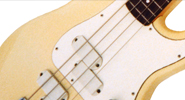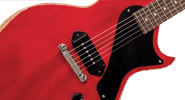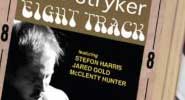
Brad Paisley’s 2011 book, Diary of a Player: How My Musical Heroes Made a Guitar Man Out of Me, is essentially an autobiography. But really, it’s not so much about him.
Anyone who has ever spoken with Paisley will tell you the “aw shucks” humbleness he exhibits on awards shows, in concert, and in the book, is not a front. So it’s no surprise that when Paisley sat to write a biography, he took the opportunity to focus on the other people who have been most important in his life… and a few guitars!
In the prologue, Paisley describes Christmas day, 1980, when, as an eight-year-old fan of the Star Wars films, he really wanted a toy – maybe a Millennium Falcon model or a light saber. Without at least one of them, he recalls thinking in the hyperbole of a child, “I would have no reason to go on.” But, he writes…“Sitting beneath a pile of presents under my grandparents’ tree was the answer to almost every question that life would throw at me, the map I needed to guide me through every twist and turn, a shield that would defend me from heartache, and a battle-axe that would lead me to victory. And one of the best friends I would ever have.”
That answer was a Silvertone model 1448 amp-in-case rig, a gift from Paisley’s grandfather, Warren Jarvis (in the book, he’s called “Pawpaw”).
“I was drawn to the guitar because it was inescapable,” he chuckled. “My grandfather so loved music and guitars, in particular, and that rubbed off on me because he made sure it did! I showed some interest in it, but like my kids… I play all the time in the house, and they show interest because I can play ‘Batman’ or the theme from the ‘Beverly Hillbillies’ when they ask me to. But I only wanted to play guitar because he wanted me to.”
Paisley describes his Pawpaw as a fairly typical guitar guy who had a few playable instruments, but nothing extravagant.
“He wasn’t wealthy, so he bought what he could to get by; he had several Yamaha acoustics, including an OM copy. He would play every day; he worked for the railroad, so he’d leave the house around four in the afternoon and get home around midnight. He also kept a guitar at work – a Yamaha copy of a Gibson Dove that he used to sit and play. It has a huge arm-wear blemish. He also had a Sekova 335 copy, which is a good guitar. I still have it. In fact, I have every guitar I’ve ever had except for a Hondo Strat copy I sold to a kid a long time ago.”
Beyond the importance of his grandfather’s passing along a passion for music – especially instrumental stuff by the likes of Buck Owens, Roy Clark, Chet Atkins, Merle Haggard, and Johnny Cash, the man made sure the young Paisley had the proper gear as he progressed.
“One day when I was 10 or 11, I had a gig at a church picnic with Hank Goddard, and we put together a little band. As I was getting ready, Pawpaw marched up the alley behind our house carrying a Deluxe Reverb in one hand and the Sekova in the other. He told my mom and dad, ‘He’s playing with Hank today, so he needs a real guitar and a real amp.’ He gave me the guitar and amp, and never did ask for them back. He knew I was headed for actual gigs. I remember him being really worried about my hearing with the Deluxe Reverb. ‘Now, this thing is loud,’ he’d say (laughs)!
“I was lucky in that a few things he gave me were amazing; my first amp wasn’t a Gorilla – it was that 1970 Deluxe Reverb!”

Through the years, a few other guitars have played essential roles in his life – most notably the ’68 Fender Telecaster in Paisley Red finish that accompanied him on his ascent to stardom. But more recently, a guitar entered his realm that speaks to the fact that his, at times, is indeed a charmed life.
When floods struck Nashville in May of 2010, dozens of notable performers lost millions of dollars worth of guitars, amps, and other gear stored at one of the city’s primary cartage/rehearsal facilities. Paisley was no exception; after the water receded, nearly every guitar and amplifier he was planning to use on a tour slated to begin in mere days was covered in river mud, as were the band’s drums, risers, keyboards, mandolins, P.A. speakers, and his custom-made effects rack.
After the flood, Paisley fulfilled a lifelong dream when he bought a pre-war Martin dreadnought – something he had previously deemed an unjustifiable extravagance.
Though he was familiar with the famed second-floor acoustic room at Gruhn Guitars, “I didn’t go up there much, because I could never even begin to afford anything on that floor until I had hits,” he said. “But the flood changed me profoundly as a gearhead, because until then, I was pretty cheap about stuff. Plus, by the time I could afford the type of instruments I’d always wanted, I was mostly being given them through endorsement,” he noted. “So I didn’t have to go digging for vintage guitars much. And when I did go to stores I frequent, like TrueTone in Santa Monica, my main obsession was amps, especially old Voxes, Marshalls, or Fenders. And it was always about sound. It had nothing to do with collectibility, really.”
But, acoustic guitars have played a major role in Paisley’s music, and he has known some good pieces.
“Early in my career, I had a cool old Gibson or two – some J-45s – and friends would allow me to use theirs. I used a J-185 on my first record, which is an amazing guitar. I had access. So I just wasn’t looking for something that would cost five figures! Instead, I’d think about how I could buy 10 Gibsons for the price of one pre-war Martin.
“And then the flood happened. And it’s a funny thing… I had a lot of gear that I loved get destroyed. But I also had some gear that was in storage for a reason (laughs), like, I had a bad ’70s Les Paul and some other things that were worth thousands of dollars. And I’m very fortunate that I was fully insured. So when that insurance check showed up for some of these instruments that I didn’t really love… and I’m looking at the amount on that check, thinking about how I could buy something I’ve always wanted… and I’m gonna get taxed if I don’t spend it, which is a great way to justify (laughs) spending that kind of money! It’s like, ‘Hey, if I don’t spend this, then I’m gonna give Uncle Sam this much.’ I have justified a lot of stuff that way!
“You can imagine what the flood was like – it was so heartbreaking to see a Dr. Z prototype Z Wreck that Mike Zaite made me, dripping with water – nasty water. So, I thought, ‘Well I’m going to make the best of this,’ and over the course of months I started to think about what I needed – some things I needed right away and we started to buy. Then I thought, ‘Well, what’s on my wish list?’ And I’ve always thought how I’d love a pre-war herringbone, but some of them can sound like a 1970 D-28 while others are worth $150,000.

“So I walk up to the second floor of Gruhn’s; I’m lucky in that where I live is one of the few places in the world where you can play 10 pre-war D-28s at any given time. And I just start picking ’em up and strumming them, going down the line. Some are like, ‘That’s good, I get it.’ But they weren’t enough for me to part with that kind of money. I get down to the end and I pick up this one, and the heavens part, the angels sing! I mean it’s just that good. You hear it on the first chord of my new album (the intro to the title track of This Is Country Music), and what you hear there is what it sounds like. Every time we’ve recorded with it, when they set the mics, my engineer would run into the control room, expecting to run back out and move them a little to get rid of this or get rid of that. But he never did that with this guitar. It’s got an amazing edge to the way it feels, sounds, and plays. It’s the most ridiculous thing.
“Anyway, George [Gruhn] walked up to the room while I was strumming it and I said, ‘You got any that sound like this that aren’t on this floor?’ (laughs) And you know George, he’s got his arms folded, and he’s looking at me, saying (impersonates Gruhn), ‘That may be one of the best guitars we’ve ever had in the store. I don’t think you’re going to find something else like it.’
“So I left. And I called my wife and said, ‘I just played something…’ She said, ‘Well, you should get it.’ And I said, ‘Are you kidding? It costs as much as a new car! Honey, I can’t spend that, that’s just dumb.’ She said, ‘Why’s that dumb? That’s what you do for a living.’ So I quit thinking so much and called (Nashville guitar builder/tech) Joe Glaser, and I said, ‘You gotta go up there with me.’ So he goes to Gruhn’s with me, and I pick it up and strum it and he says, ‘You need to buy that!’ He said, ‘Guitars like this belong with you and Vince [Gill] and Keith [Urban] and Brent [Mason] and guys in our town. It shouldn’t be in a vault.’”
In Diary, Paisley writes, “So as I was wrapping my head around actually owning this gem, the Gruhn’s staff brought out a framed account of the guitar’s history written by the daughter of the man who had owned it for most of its long life.” He then tells the story of how Gruhn’s acquired the guitar from a family in San Diego whose father had left it to them upon his passing in 1994. Turns out, the man was originally from Paisley’s home state of West Virginia, and even better, he, like Paisley’s grandfather, worked as a telegrapher – just one station down the B&O Railroad line – in the years after World War II. Paisley deduces that the two men likely knew each other, communicated regularly via telegraph, and both probably spent many hours strumming guitars at their posts.
“When [Gruhn’s staff] showed me this framed thing that tells how the guitar comes from where I come from, and it belonged to a man who may have interacted with my grandfather… I was astonished. It’s a West Virginia herringbone! And there’s not a lot of West Virginia herringbones left (laughs)!
“So I drove away again, called my wife again, and said, ‘I don’t know how I can’t do it.’”
So it was, folklore may tell the tale, about how fate and a terrible flood teamed up to put one very special 1937 Martin D-28 with herringbone trim in the hands of a certain country-music superstar.
Special thanks to Kendal Marcy.
This article originally appeared in VG’s January 2012 issue. All copyrights are by the author and Vintage Guitar magazine. Unauthorized replication or use is strictly prohibited.






 Gruhn Guitars is set to offer for sale the earliest known custom-color black Fender Stratocaster. Musician Howard Reed, Jr. (1937–’81) ordered the guitar in 1955 through McCord Music Company, in Dallas. In ’58, Reed joined Gene Vincent and His Blue Caps and used the Strat as his primary guitar onstage. He also used it on “The Big D Jamboree,” on CBS Radio in Dallas. It carries a neck date of 11-55, and tape in the control cavity signed by Gloria (one of Fender employee who assembled it). Reed applied three stickers with his initials “H A R” to the upper bass bout.
Gruhn Guitars is set to offer for sale the earliest known custom-color black Fender Stratocaster. Musician Howard Reed, Jr. (1937–’81) ordered the guitar in 1955 through McCord Music Company, in Dallas. In ’58, Reed joined Gene Vincent and His Blue Caps and used the Strat as his primary guitar onstage. He also used it on “The Big D Jamboree,” on CBS Radio in Dallas. It carries a neck date of 11-55, and tape in the control cavity signed by Gloria (one of Fender employee who assembled it). Reed applied three stickers with his initials “H A R” to the upper bass bout.












